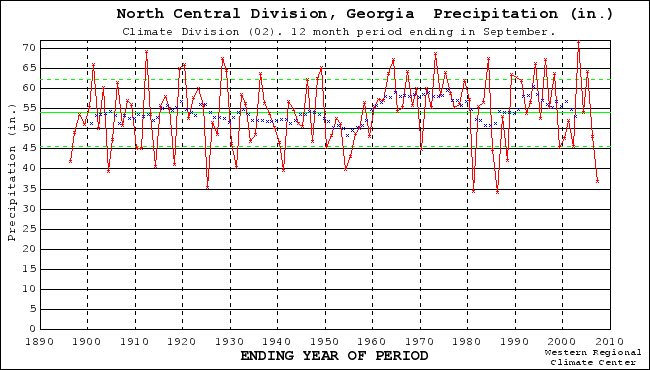 Reader Tim rightly points out that my Georgia rainfall graph is the state as a whole, while the drought is primarily confined to the northern part of the state. Here’s the north-central Georgia climate division. (The northwest and northeast graphs look quite similar.) I think the point is similar. Depending on what time scales you’re looking at, you can again see repeated similar dry spells across the 20th century, especially during the 1980s. Tim said the Atlanta papers have been saying soil moisture is at a 100-year low. Given the general poor quality of soil moisture time series in this country, you can color me skeptical on that claim. But the University of Washington VIC group, my standard source for soil moisture, has a bullseye of 100-year low sort of soil moistures in the Carolinas, but most of northern Georgia looks from the VIC map to have more like a 5th to 10th percentile sort of soil moisture condition.
Reader Tim rightly points out that my Georgia rainfall graph is the state as a whole, while the drought is primarily confined to the northern part of the state. Here’s the north-central Georgia climate division. (The northwest and northeast graphs look quite similar.) I think the point is similar. Depending on what time scales you’re looking at, you can again see repeated similar dry spells across the 20th century, especially during the 1980s. Tim said the Atlanta papers have been saying soil moisture is at a 100-year low. Given the general poor quality of soil moisture time series in this country, you can color me skeptical on that claim. But the University of Washington VIC group, my standard source for soil moisture, has a bullseye of 100-year low sort of soil moistures in the Carolinas, but most of northern Georgia looks from the VIC map to have more like a 5th to 10th percentile sort of soil moisture condition.
As for Atlanta itself, it’s received a bit more than 34 inches at the airport in the “water year” (Oct. 1 to Sept. 30). The airport’s records go back to 1930. This is the seventh year since 1930 that it has been in the 35 inches or less range. In other words, the actual Atlanta rainfall, if it is a useful gauge, is about a once every ten year phenomenon. In terms of two-year accumulations, the return interval is similar.
By that data, northern Georgia is clearly living on the dry edge right now of the normal range of variability.
Don’t get me wrong here. I’m not arguing this is not a serious situation. It is clearly extraordinarily dry there. But it should not be viewed as some amazingly surprising and unexpected event. The past record shows that dry periods similar to the one Atlanta is now experiencing have repeatedly occurred in the instrumental record. Another comment worth pulling out from the same thread, this by Dano:
RP Sr said the same in a paper about the Colorado drought that peaked in 2002 – CO society is less resilient than in the past. GA society is also less resilient than in the past, not more. You’d expect that an advanced society would become more resilient over time. Instead, we are moving backwards.

Or, were we ‘lulled’ into lower resiliency? Besides the late-1990s period you point out, look at the 1960-1980 period. Only a single year below the mean – nearly two decades of above average precip! That can fool any politician working on 2-4 yr time-scales. “We never have drought issues here” [perhaps spoken in the mid-1970s when approving inefficient water-usage projects].
The figure you’ve made shows wetter than average conditions over the last 40 yrs except for a few brief droughts. What would they think if they saw the last 1000 yrs?
Check out the uptick towards the last 1000 yrs of summer drought in the area around Atlanta GA: http://picasso.ngdc.noaa.gov/paleo/data/tmp/CkPDSI229,238,230,239.gif
or the northern border of GA: http://picasso.ngdc.noaa.gov/paleo/data/tmp/CkPDSI229,238.gif
Look at the droughts between 1600-1900. The current drought might not be too severe.
Find a copy of Dave Stahle’s 1000 yrs of spring drought in the southeastern US. It is a must read.
Data source: http://www.ncdc.noaa.gov/paleo/newpdsi.html
Pingback: jfleck at inkstain » Georgia Drought In Perspective